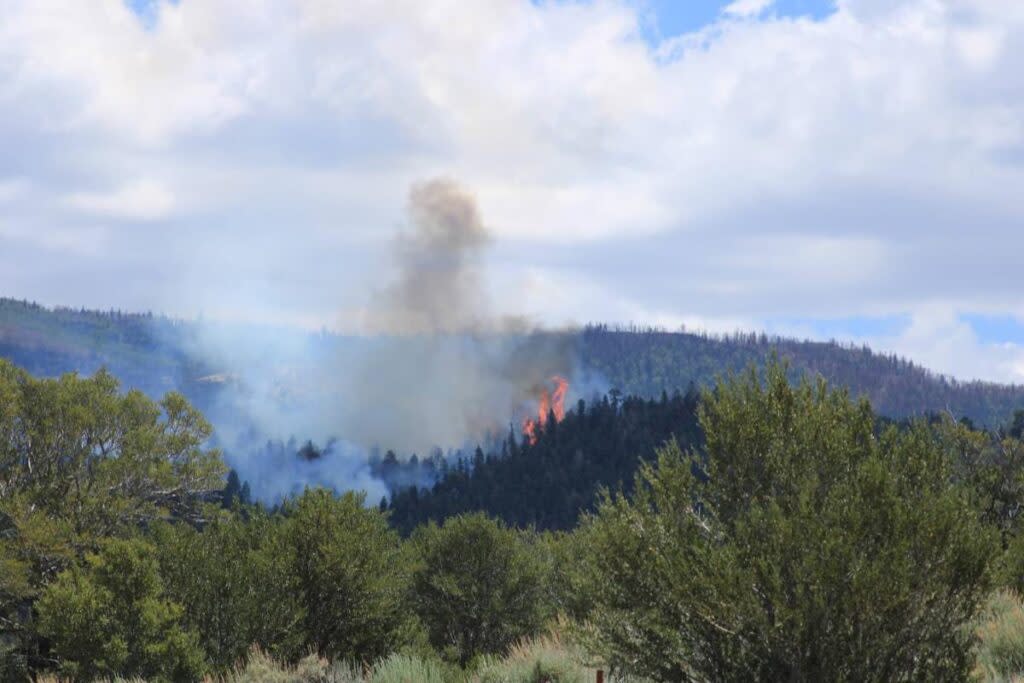Hot, dry weather brings ‘critical’ fire danger to Utah ahead of holiday weekend

The Little Twist Fire burns in the Fishlake National Forest near Beaver, Utah, on Monday, July 1, 2024. (Photo courtesy of Utah Fire Info)
With much of Utah expected to see ripe wildfire conditions for the foreseeable future, restrictions are in place and officials are on edge heading into the holiday weekend.
Anyone looking for a rainy reprieve on the heels of one of the hottest Junes on record in Utah will have to wait, says Basil Newmerzhycky, lead meteorologist with the Great Basin Coordination Center, an interagency group that includes the Bureau of Land Management, Forest Service and state agencies.
Summer monsoons, which often bring rain to parts of Utah during the summer, are currently being suppressed and are “highly unlikely” for the rest of July, said Newmerzhycky. That means the fire outlook will only worsen, with vegetation across the state continuing to dry.
“We’re expecting our fuels to dry out to critical levels, probably statewide, in the next five to 10 days,” he said on Tuesday.
GET THE MORNING HEADLINES DELIVERED TO YOUR INBOX
This past weekend, the Utah Division of Forestry, Fire and State Lands implemented Stage 1 Fire Restrictions for parts of northern Utah. The restrictions, which cover all unincorporated private and state land in Box Elder, Cache, Rich, Weber, Tooele, Utah, Salt Lake, Davis and Morgan counties, are as follows:
No fireworks, tracer ammunition, exploding targets or other pyrotechnic devices.
No open fires, unless they’re built in improved campgrounds or in permanent fire pits on private property with running water.
No smoking, unless it’s in an enclosed vehicle or structure, a developed recreation site or paved area.
No cutting, welding or grinding metal near areas with dry vegetation.
No operating a motorcycle, chainsaw, ATV or other small engine without a working and approved spark arrestor.
The restrictions do not apply to incorporated cities and towns, which may have their own restrictions.
“Human-caused wildfires are currently at their highest levels in the past three years. Once again, Utah received a lot of snow this year, resulting in new growth of grass and shrubs. With all this additional vegetation, it only takes one spark to start a wildfire,” said Dustin Richards, fire management officer with the division.
The state’s largest blaze, the Little Twist Fire in Fishlake National Forest near Beaver, is currently burning over 2,600 acres and was about 25% contained as of Tuesday, according to data from the U.S. Forest Service. Though it started as a prescribed burn, Newmerzhycky warned Utah could see more fires that size as the state continues to dry out.
The big difference between a 300-acre fire and a 3,000-acre fire, he said, is sagebrush. Spring rain triggers all kinds of vegetation growth, but grasses tend to dry out the fastest — by June or early July, they’re primed for a fire. Early summer fires that stay within 100 to 500 acres are often a result of burning grass.
But sagebrush takes longer to dry out, and can actually slow the spread of early season fires. As Newmerzhycky puts it, sagebrush is “the only thing stopping it from getting crazy in Utah.”
That vegetation is expected to reach critical levels in the next week or so, which is when it becomes part of what’s called the “fire environment.”
“Once the sagebrush dries out at lower elevations, that’s the final straw, where things really could start picking up. We’re a little anxious with this very hot and dry wave coming in this weekend,” said Newmerzhycky.
Last summer was relatively mild for wildfire activity — that only makes this summer more dangerous, officials say, resulting in “carryover fuels.”
“We had such a less intense fire season last year, which makes this year more potent because a lot of stuff that could have burned is now combining with new grass,” Newmerzhycky said.
All that comes as Utahns are gearing up for Fourth of July celebrations. State officials, from the governor to public lands employees, are crossing their fingers that celebrations stay responsible.
The Fourth of July is “always worrisome,” said Newmerzhycky
“It seems like every year when we’re in a warm, dry period, we have tons of fires popping up here in the Wasatch Front,” he said. “Thursday is going to be a pretty hot day, so we’re kind of concerned and holding our breath.”
The post Hot, dry weather brings ‘critical’ fire danger to Utah ahead of holiday weekend appeared first on Utah News Dispatch.

